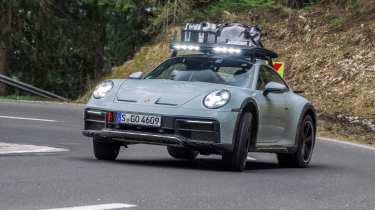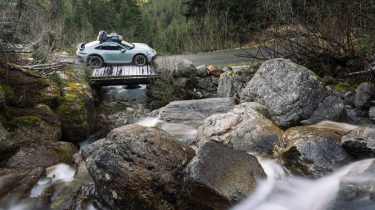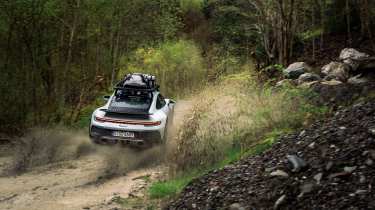Porsche 911 Dakar 2025 review – more capable than a Lamborghini Huracán Sterrato?
The desert launch of the 911 Dakar suggested a car for adventures. Cue a 1200-mile road trip on (and off) some of Europe’s best roads...
I turn to look at Aston. Aston turns to look back at me. We turn our heads in unison back to the closed barrier ahead through the windscreen. Oh, bother. We’re in the Austrian Alps, aiming for what promises to be a spectacularly photogenic location via a mountain pass. Only problem is, there’s a makeshift barrier in place ahead of us. We’re not sure who put it there, or why, or if moving it would technically be trespassing. To get to the location we have in mind by another route would take around three hours, maybe four.
We sink dejectedly a little deeper into the 911 Dakar’s carbon bucket seats. Its 3-litre flat-six thrums away patiently behind us, idling expectantly. Google Maps is scrolled. There is another possible route. It involves a bit of a detour. And a bit of off-roading. And possibly a bit of charm, or pretence at being stupid English tourists if somebody stops us. (The latter’s not too much of a stretch, for me, at least.) Is the 911 Dakar a proper go-anywhere machine for adventures? Reaching for the ride height lift button, I guess we’re about to find out.
> Porsche 911 review 2025 – Gen2 992 is the 911 for the digital age
More reviews
Group tests
In-depth reviews
- Porsche 911 review 2025 – Gen2 992 is the 911 for the digital age
- Used Porsche 911 (991, 2011 - 2018) review – should you buy the unloved 911?
Long term tests
Reviews
Rewind to Stuttgart, a few hours and a few hundred miles ago. We meet the 911 Dakar for the first time at Porsche’s Zuffenhausen HQ, steady rainfall polishing the highlights on its metallic Shade Green paint. It’s the last time this car will be clean until we return it, three and a half days from now.
We have that time to get to know the 911 Dakar properly, and for it to answer some questions that, for now, remain intriguing unknowns. So far, our only Dakar driving-seat exposure has been at its international launch in Morocco, where we got to grips with both the car and the Saharan sand dunes. The verdict was good, very good: the Dakar proved itself as a convincing off-roader without losing its essential 911-ness.
But we still don’t know how it feels on the road, how it feels in European traffic, how it feels in real life, really. Is the Dakar – limited to 2500 cars and priced at £173,000 to the 911 GT3’s £146,400 – a cynical concoction aimed at investors, a lifestyle-over-substance marketing project, or a genuinely compelling car?
We’ve steepened the lifestyle angle by asking for the car to be fitted with the roof rack system from the Porsche Tequipment options list, partly because we’re unsure if our bags and photography gear will fit in the half-roll-caged interior, but also partly because – cards on the table – it might look good in photos. And looking good in photos is tacitly a big part of the Dakar’s commercial and marketing appeal: surely there’s no more Instagram-ready car in the current Porsche line-up. And along with the waterproof luggage bag at the rear of the rack, Porsche has added a few choice items from its catalogue, including water canisters, a folding spade and recovery boards to stick under the tyres.
Depending on your standpoint, it’s either brimming with visual appeal or a bit try-hard, like walking around in safari-suit fancy dress (and there are opinions on both sides of the fence in an evo office straw poll).
Post-options, this car weighs in at around £185,000 as tested, the priciest extras being that headgear (£4300 for the roof rack with built-in high-intensity spotlights, and another few hundred pounds cumulatively for the items attached to it), the paint (£1919), Burmester surround-sound system (£2265), and interior Rallye Sport package (£2475), with that half cage. Mind you, as many as three-quarters of 911 Dakar customers are forecast to fork out £18k alone for the Rallye Design Package, with faux Rothmans graphics or a choice of other retro rally liveries.
We get the camera tripod and smaller bags in the back, through the gaps in the roll-cage (like a ship in a bottle, getting them out again later will prove trickier) and there’s still the deep front boot underneath the carbonfibre bonnet borrowed from the 911 GT3, so light it feels as if you’re going to throw it over the roof when you first lift it. It turns out we don’t need the waterproof dufflebag or extra space on the roofrack after all.
Those accoutrements are definitely helping the Dakar turn heads, though. We need to cross the concourse of the Porsche Museum to leave the Zuffenhausen grounds, and smartphone-swivelling passers-by flock to the raised-up, knobbly-tyred, roof-racked Dakar. The row of 911 GT3s and an immaculate 993 lined up outside the museum’s doors are temporarily ignored.
Paparazzi evaded, we point the Dakar’s nose south to the Austrian border. As the miles tick by on the autobahn, the rain turns from drizzle to deluge and the Pirelli Scorpion All-Terrain tyres, all chunky tread blocks and sipes galore, cut through pockets of standing water as if the road’s bone-dry. They kick out a fair bit of road noise; although, then again, so does a regular-tyred 911. The roof basket is actually incredibly quiet below 75mph or so, then joins in with a subtle but insistent whir of airflow. With the rear seats deleted – whether you opt for the cage or not – it’s a bit boomier in the back too, but it’s not necessarily a bad thing: the 473bhp 3-litre twin-turbo engine, taken straight from the 911 GTS, sounds huskier and harder-edged as a result, playing the rally-car role with conviction.
If any prospective 911 Dakar customers happen to be reading this, don’t bother with the pricey Burmester system; it struggles to cut through the cumulative effect of all that low-level background noise, all muddy bass and tinny treble. But the Dakar is honestly no hardship to drive on a long motorway slog. You can hold an easy conversation at motorway speeds, and overall it’s an undemanding car in which to cover ground. Refined, even. Biggest drawbacks are the bucket seats – ultra-comfy at first then much harder work as minutes become hours – and the effect the roof cargo is having on the fuel consumption. When weather and traffic clear and we begin to press on (the all-terrain tyres are still rated to 149mph), the trip computer reckons on an 18-19mpg average.
But the most interesting question isn’t how it feels on the motorway, of course: what does the raised ride height – 50mm loftier than a 911 Carrera on Sport suspension – and knobbly tyres mean for the handling on a winding road? Nearing the border, it doesn’t take long to find the perfect setting: friendly cambers, quiet hairpins, fast curves and full-stop braking zones. The sort of road you’d really enjoy in a regular 911, in other words…
And the Dakar is genuinely great fun too. It’s a bit more remote in feel, but you still know exactly what’s going on and feel comfortable driving it to its limits sooner than you would most sports cars. And those limits are much lower: the all-terrain tyres relinquish grip much more readily, but they still do so progressively, and the Dakar doesn’t feel clumsy. In fact, having lower limits kind of makes it more fun: in the hairpins, selecting Rallye mode (unique to the Dakar and technically intended for loose surfaces) biases the active torque split to bundle the lion’s share to the rear axle, and it’s addictively easy to slither around slow corners, the tail taking a wider arc than the front. It’s refreshing to have the option to drive a modern car with accessibly low limits, and the tyres regain grip quickly when they slide.
It’s still stable in the fast corners, too, perhaps helped by the rear-wheel-steering system, standard fit on the Dakar, doing its thing to virtually lengthen the wheelbase.
The weak spot is under braking, where the Dakar gets up on its treadblock toes and feels reluctant to slow – sometimes disconcertingly so. But once you’ve adapted to it and recalibrated your braking points further up the road, it’s a generally lovely thing to drive. Less sharp and responsive than a regular Carrera, of course, but less blunt than its appearance suggests.
The suspension is on longer struts but otherwise its architecture is essentially the same as a regular 911’s. And it’s still thumpingly fast: the sub-4.0sec official 0-62mph time feels believable. Various weight-saving measures, the lightweight bonnet and rear-seat deletion among them, have kept weight to within 10kg of a regular PDK-equipped Carrera 4.
You can fit the Dakar with regular summer or winter tyres but I wonder how it would feel; the spring rates have been softened by a full 50 per cent compared with a Carrera 4, partly because the Scorpion tyres’ sidewalls are so stiff. With regular-profile tyres, I wonder if the suspension’s movements might actually feel a little baggier as a result – it would be interesting to find out. As it is, ride quality, aided by the standard adaptive dampers, is superb, somehow always the right side of too firm or too soft.
Back to that impasse. We backtrack a few miles down the road, and then leave it completely, travelling by turn via muddy trails and over lush green hillsides against an Alpine backdrop so picturesque you half expect Julie Andrews and the von Trapp family to appear around the next corner. You can bump the Dakar up a further 30mm, using a pneumatic lift kit powered by a compressor behind the front seats (and, amusingly, it can stay at that height at up to 105mph before lowering automatically), and it has a further bespoke Off Road driving mode, nominally splitting the torque 50:50 – though it’s still actively fine-tuned on the fly – and prioritising traction at all costs. It would be nice to have a manual gearbox to play with but the eight-speed PDK transmission works better with the different drive modes and active all-wheel-drive system, so, understandably, it’s the only transmission available in the Dakar. And a slightly annoying one on dual carriageways, too, constantly hunting for the right gear and changing its mind, even on a steady throttle.
At the moment I’m letting it do its own thing, both hands on the wheel and sitting back in mild awe at the terrain passing below the Dakar’s mildly strengthened belly. We’re into forest now and a steep hillside; the 911 is climbing, climbing, stopping only when it runs out of road, not out of puff. There’s no main central radiator, the Dakar instead getting a pair of higher-performance rads either side of its nose, enabling a steeper approach angle at the front. It’s surprising just how steep an incline you can point it at, and how much purchase the tyres find to propel the Porsche up it.
Reversing easily down from this dead end, we try a different tack and find ourselves on a winding road that climbs, narrows, darkens and emerges into a snowy wonderland, like driving through a wardrobe into Narnia. At one point we find ourselves crossing a narrow but sturdy bridge over a waterfall, not another soul in sight and only the sound of babbling water and distant calling birds on the breeze. Far below us, I can see the valley we started from. We couldn’t have got here in a Carrera 4.
We climb further and further still, until we’re finally foiled by deep snow. The Dakar gamely motors on, trudging through the snow up to its axles before the tyres finally cry enough and spin on the spot in protest. For a very real moment it looks like we might need the Porsche-branded shovel and tyre tracks after all, but a bit of careful steering and throttle work, and a favourable luck:judgement ratio, sees us reverse clear and backtrack to solid ground.
We haven’t reached the El Dorado photo location we’d been heading for. But we’ve reached somewhere perhaps even better, not only because it’s beautiful – a suntrap clearing, fringed with tall trees shedding snowflakes and a backdrop worthy of the National Geographic – but because of the adventure we’ve had getting here.
By the time we return the Dakar to Stuttgart, mobbed by cameras again outside the Porsche Museum like automotive Beatlemania – or should that be Beetlemania in this case? – we’ve covered 1200 miles. As far as we are aware, this is the longest trip any magazine has yet undertaken with the Dakar. It’s let us get under its skin, and the car ours. Every time we’ve questioned it, it’s had an answer.
Yes, there were times, particularly driving into a down-at-heel part of a random Austrian town en route, that we felt, honestly, a bit self-conscious to be driving a moodboard on wheels, but there were other settings where the car looked fantastic. In an even more subtle colour, with roof bars, perhaps, but without the whole Bear Grylls expedition pack, I reckon it’s a car with genuinely deep appeal. The interior could be more special; apart from (optional) rubber floormats and a ‘911 Dakar’ plaque, there’s not much to separate it from a regular 911. As a long-distance car, comfort is compromised a little by the fixed shell seats and definitely by the optional half-cage.
But the fact that the Dakar has the bandwidth to shoulder long motorway slogs, park up in a city, blitz a mountain road or venture off that road into the mountains themselves is truly impressive. It may cost £45k more than the 911 Carrera 4 GTS that it uses as its source material, but it does offer a bigger experience, opens up greater opportunities, turns more of the map into a playground. On the journey’s return leg, now knowing the car’s capabilities, we feel able to dive off the road at any juncture. A dirt path up to a waterfall spotted in the distance becomes another place to explore; a shallow section of water adjacent to a road becomes a place for the 911 to paddle in, like a rhino paying a visit to a watering hole. As a result it’s made memories on this trip that wouldn’t have been possible in most ‘normal’ 911s. Even if some of those memories might have involved borderline trespassing.
Maybe it’s the fatigue talking after cramming a lot of miles and landscapes into a short space of time, but I’ve fallen under the Dakar’s spell. Its appeal is real and rounded, and the best answers to any questions asked of it are revealed by using it. As it turns out, it’s definitely a car that deserves to have miles put on it, rather than stay put in a collection.
Porsche 911 Dakar specs
| Engine | Flat-six, 2981cc, twin-turbo |
| Power | 473bhp @ 6500rpm |
| Torque | 420lb ft @ 2300-5000rpm |
| Weight | 1605kg (299bhp/ton) |
| 0-62mph | 3.4sec |
| Top speed | 149mph |
| Basic price | £173,000 |
This story was first featured in evo issue 310.










